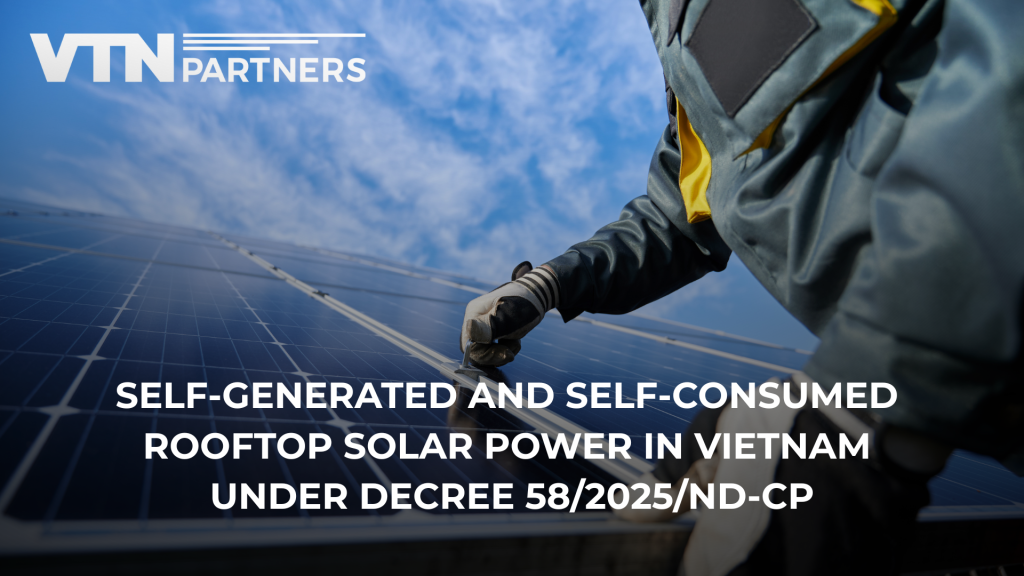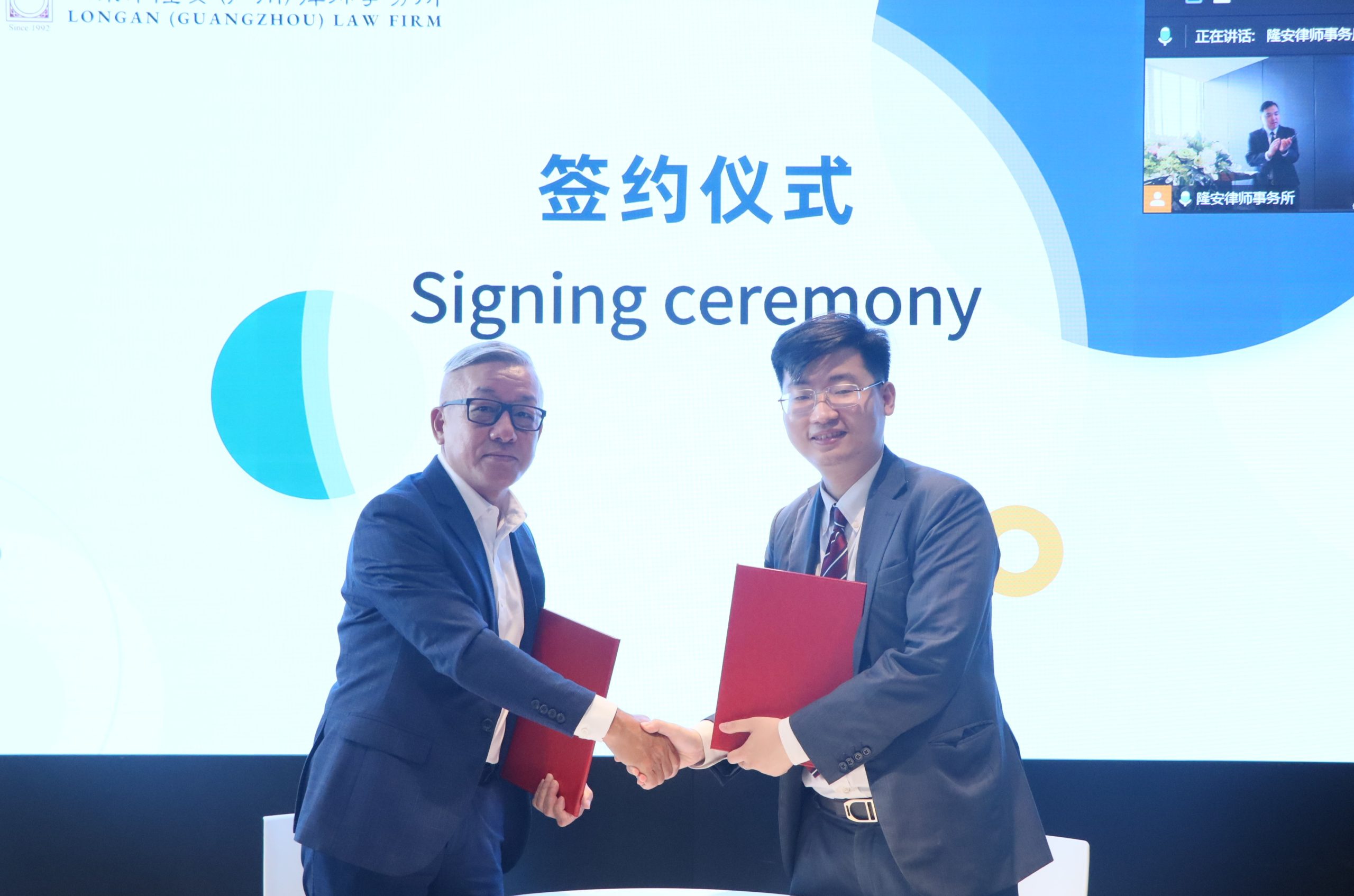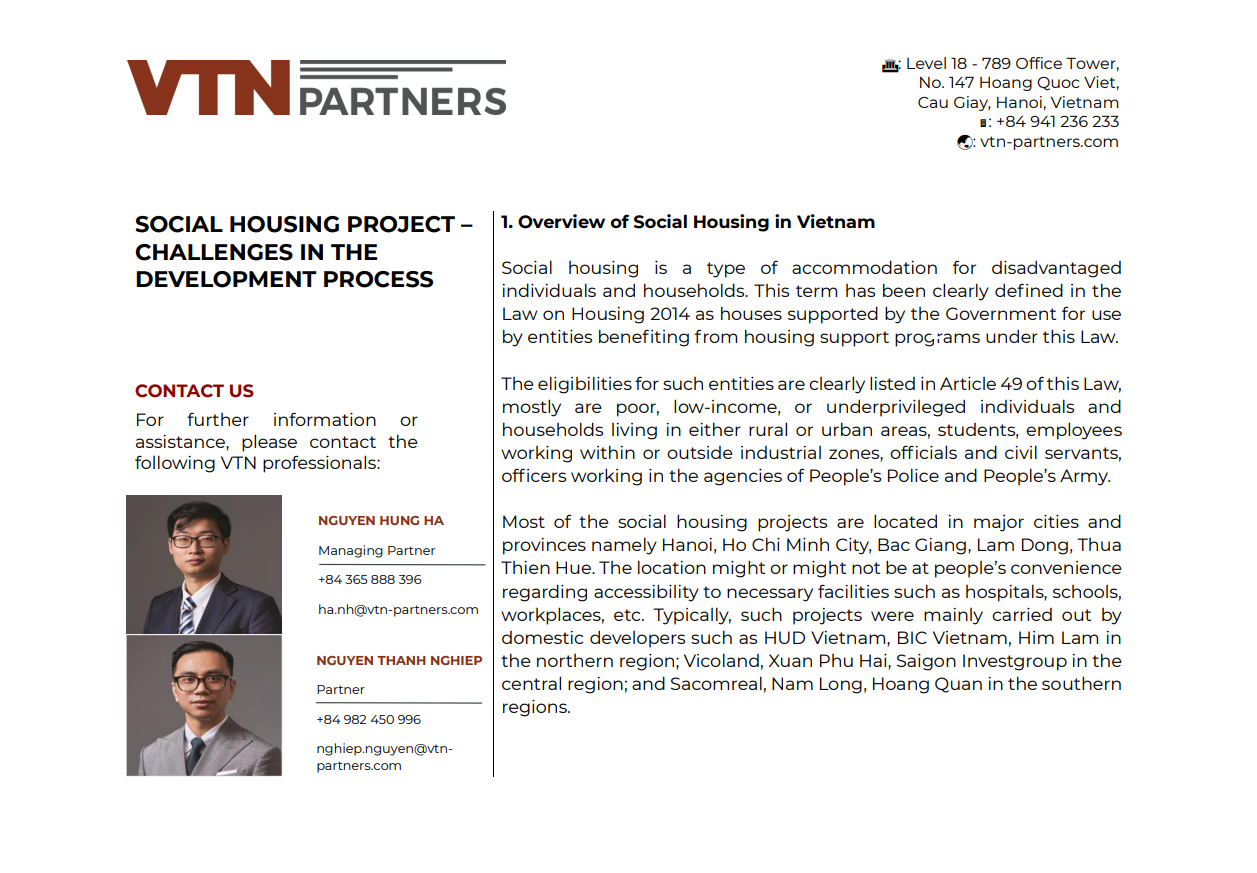On March 3, 2025, the Vietnamese government issued Decree No. 58/2025/ND-CP, which provides detailed regulations on several aspects of the Law on Electricity concerning the development of renewable and new energy sources (“Decree 58”). This decree takes effect immediately and replaces Decree 135/2024/ND-CP dated October 22, 2024, which set out policies encouraging the development of self-produced and self-consumed rooftop solar power (“Decree 135”).
As a result, many regulations under Decree 135 governing the criteria and procedures for self-produced and self-consumed rooftop solar (“RTS”) power projects have been replaced by new ones in Decree 58. This article outlines the key changes in RTS activities from Decree 135 to Decree 58.
1. Broader and More Detailed Compliance Requirements
- Notification Requirements
Under Decree 135, developers of self-produced and self-consumed RTS power systems that are non-grid-connected, or grid-connected but with an installed capacity of under 100kW had to make certain notifications to the Department of Trade and Industry and to firefighting and prevention authorities[1]. Developers of systems with capacities between 100 kW and 1,000 kW had to notify not only these authorities but also relevant electricity units[2].
Decree 58 introduces the following updates:
- Developers of self-produced and self-consumed RTS power systems not connected to the national power grid, or connected but that do not sell surplus electricity to the national power system, must make a notification to the Department of Trade and Industry[3]. The decree specifies what must be included in the notification, such as the project’s name, type of electricity source, and other key details[4], providing more clarity than the previous decree.
- Developers of self-produced and self-consumed RTS power systems that sell surplus electricity to the national power system must make a notification to the Department of Trade and Industry and carry out procedures for granting electricity operation licenses, except for cases exempted from electricity operation licenses according to regulations[5].
- Households connected but with an installed capacity of under 100kW must make a notification to the Department of Trade and Industry, electricity units, construction management agencies, and local fire prevention and fighting agencies for management, monitoring, and guidance on implementation in accordance with legal regulations[6].
- Developers of self-produced and self-consumed RTS systems with an installed capacity of less than 1,000 kW connected to the national power system and not registering to sell surplus electricity output must make a notification to the Department of Trade and Industry, electricity units, and local construction and fire prevention and fighting management agencies for management, monitoring, and implementation guidance in accordance with regulations[7].
- Development Registration Certificate
Under Decree 135, developers of grid-connected self-produced and self-consumed RTS systems with an installed capacity of 1000kW or more and that feed surplus electricity to the national grid had to obtain development registration certificates[8].
Decree 58 changes this requirement as follows[9]:
- Developers of grid-connected self-produced and self-consumed RTS systems with an installed capacity of 1,000kW or more.
- Developers of power sources with an installed capacity of less than 1,000 kW that do not sell surplus electricity output but need to be granted a development registration certificate.
- Developers power sources with an installed capacity of less than 1,000 kW register to sell surplus electricity output to the grid of the surplus electricity buyer, except for: (i) households developing power sources with a capacity of less than 100 kW on the roof of individual houses; and (ii) mountainous, border and island areas that have not been supplied with electricity from the national power system.
- Electricity Operation Licenses
Under Decree 135, developers of self-produced and self-consumed RTS systems that have an installed capacity of 1,000kW or more and intend to sell surplus electricity to the grid are required to obtain an electricity operation license[10].
Under Decree 58, developers who sell surplus electricity to the national power grid must now go through procedures to obtain an electricity operation license, unless exempted by the Electricity Law[11].
2. Compliance with Electricity Development Capacity Regulations
Decree 58 clarifies compliance with national electricity planning and network development requirements:
- Developers must ensure that their system capacities align with national electricity development plans and local network plans.
- Organizations or individuals developing self-consumed RTS systems are responsible for calculating their system size based on their own electricity needs.
- It encourages the installation of energy storage systems that suit the user’s electricity needs, with potential mandatory requirements.
The development capacity of self-produced and self-consumed electricity sources is also specifically regulated regarding the maximum capacity according to the following formulas[12]:
- For organizations or individuals purchasing electricity from a power company using a single-phase meter:
Pmax = (Udđ x Idđmax x kc)/√3
- For organizations or individuals purchasing electricity from a power company using a three-phase meter:
Pmax = √3Udđ x Idđmax x kc
Where:
Udđ: The voltage level at which the organization or individual purchases electricity from the power company (0.4 kV; 6 kV; 10 kV; 22 kV, or other applicable voltage levels);
Idđmax: The maximum current of the meter (as recorded on the meter);
kc: The transformation ratio of the current transformer, which is the ratio between the rated primary current and the rated secondary current (if applicable).
3. Sale of Surplus Electricity
Parties to the Transaction
- Seller
Under Decree 135, sellers of surplus electricity were limited to self-produced and self-consumed RTS systems connected to the national power grid, with a capacity consistent with local generation plans. This also included systems installed in households with capacities under 100 kW[13].
In Decree 58, the category of sellers is expanded to include organizations and individuals in mountainous, border, and island areas that are still connected to local power grids but have not yet been integrated into the national power system[14].
- Buyer
The surplus electricity buyers are also now different. Under Decree 135, Vietnam Electricity (“EVN”) or its authorized units were the direct buyers of surplus electricity. According to Article 3.2 of Decree 58, subsidiaries and authorized member units of EVN are now the buyers. It means that EVN is no longer the direct buyer of the surplus electricity.
- Amount of Surplus Electricity for Sale
Under Decree 135, the maximum amount of surplus electricity that could be sold to the grid was limited to 20% of the system’s actual installed capacity[15]. Decree 58 introduces a more detailed formula for calculating the electricity output. The new decree specifies that the maximum amount of surplus electricity that can be sold is 20% of the electricity generated by the RTS power system, based on radiation intensity[16].
However, there is an exception for mountainous, border, and island areas not yet connected to the national power grid, where there is no limit on the amount of surplus electricity that can be sold[17].
- Price of Surplus Electricity
Under Decree 135, the price of surplus electricity fed back to the national power system had to be equal to the average market electricity price in the preceding year announced by the power system and electricity market operator[18].
However, Decree 58 now provides a formula for calculating the price, based on two variables: the surplus electricity output into the grid of the buyer and the monthly production of electricity from the RTS energy of the seller[19]. In detail, if the surplus electricity exceeds 20% of the calculated output (Ai), only 20% of Ai will be paid for. Otherwise, if the surplus electricity is less than 20% of Ai, the full amount of surplus electricity will be paid for, as measured at the meters.
[1] Articles 6 & 7.5 of Decree 135[2] Article 7.6 of Decree 135[3] Articles 12.1 & 12.2 of Decree 58[4] Article 12.1(a) of Decree 58[5] Article 12.3 of Decree 58[6] Article 15.2 of Decree 58[7] Article 15.3 of Decree 58[8] Article 9.3 of Decree 135[9] Articles 13.2 & 16 of Decree 58[10] Article 8.2 of Decree 135[11] Articles 12.3 & 14.7 of Decree 58[12] Article 11.3 of Decree 58[13] Article 8.7 of Decree 135[14] Article 14.1(c)[15] Article 8.7 of Decree 135[16] Article 14.2 of Decree 58[17] Article 14.6 of Decree 58[18] Article 8.7(b) of Decree 135[19] Article 14.3 of Decree 58








